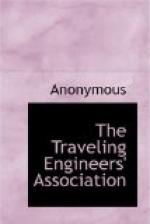186. Q. If the brake cylinder pipe breaks and is not plugged, what must be done?
A. Close the cut-out cock in the main reservoir supply pipe, this to avoid the waste of air when a brake application is made on the train.
187. Q. If the brake pipe connection to the control valve breaks, what should be done?
A. Plug the end leading from the brake pipe; the automatic brake cannot be applied on the locomotive, but the independent brake will not be affected.
188. Q. If the control cylinder pipe breaks, what effect will it have and what must be done?
A. The locomotive brake cannot be applied with the automatic brake valve; by plugging the pipe, this feature of the brake will be restored, but the independent release feature will be lost.
189. Q. If any of the pipes here enumerated breaks, will it in any way affect an application of the independent brake?
A. No; as the independent and automatic features are entirely separate from each other; that is, the automatic control valve is not brought into use when an independent application of the brake is made.
CONTROL VALVE DEFECTS
190. Q. If there is a blow at the control valve exhaust port when the brake is released, where would you look for the trouble?
A. This would indicate a leaky application valve, or a leak past the emergency valve.
191. Q. If there be a continuous blow at the control valve exhaust port when the brake is applied, where would you look for the trouble?
A. This would indicate leakage past the exhaust valve 7.
192. Q. If the locomotive brake released with the automatic brake valve in lap position, where is the trouble?
A. Would look for a leak in the control reservoir pipe or special release valve.
193. Q. If the brake remained applied in lap position, but released in release or holding position, where would you look for the trouble?
A. This would indicate a leak in the control valve release pipe.
MISCELLANEOUS
194. Q. What is meant by an application of the brake?
A. The first and all following reductions, until the brake is released.
195. Q. How many applications of the brake should be made when making a stop with a passenger train, and why?
A. Two; the first a heavy one to reduce the speed quickly, and the second a light one to complete the stop; thereby preventing wheel sliding and shock to the train.
196. Q. How many applications of the brake should be made when making a stop with a long freight train?
A. One; this to prevent the possibility of causing damage to the train.
197. Q. Explain how a stop should be made with a freight train.




